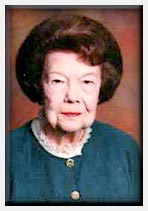The Pampa School Building at 126 West Francis |
|
 Eloise Lane
Eloise Lane
A two-story tan brick building at 126 West Francis was completed in 1920 at a cost of $50,000. The building contained rooms for the eleven grades of the Pampa school system and an auditorium on the second floor. The school board members, who were also members of Pampa Masonic Lodge #966, were Nels Walberg, president; L. C. McMurtry, secretary; P. C. Ledrick, L. H. Greene and J. M. Daugherty, Jr. On Tuesday, August 3, 1920, after a called meeting of the Masons, a procession was formed and proceeded to the school building where the cornerstone was laid. The school board member who was to be the main speaker got so nervous that he could not say a word. Some of his friends said it was just as well that he did not speak because no one except his wife was ever able to under- stand what he said. Miss Virgin, one of the teachers, was instrumental in convincing the stu- dents that green and gold would be the most appropriate colors for the school. She got her idea from the green and gold wheat growing on the farms. With Ray Wilson as editor-in-chief, the Pampa High School class of 1920-21 produced the first annual, "The Harvest," dedicated to the board of trustees. H. R. Silvey was the superintendent and the teachers were Ms. Martin, Ms. Waitman and Mr. Scoggins. The PHS class of 1921 was composed of Otis Carruth, president; Ruby Henry,secretary; Gladys Pipkin, Wilma Chapman, Alton Scoggins, Julia May Barnhart, Lois Barrett, Kathleen Rider, Eddie Crow, Margaret Schmidt and Ray Wilson. Post-graduates were Jack Vincent, Ruth Barrett and Noble Roberts. The class motto was "We finish to begin." The colors were green and pink and the flower was a pink rose. From 1920 to 1930 the population of Pampa increased by 959 percent, attri- butable to the oil and gas industry. By 1923-24 some of the lower grades were transferred to the red brick building at 309 N. Cuyler. About 1925-26 frame buildings facing Cuyler and Browning were constructed to provide additional classrooms. The east wing of the high school building was constructed in 1928 for junior high grades and a west wing was added to the high school on June 2, 1930. The auditorium was made into classrooms and PHS students practiced and presented programs in the auditorium at the north end of the second story of the City Hall. Graduations were observed at various churches.
Pictorial Pampa (ca 1931) shows a picture of the buildings that occupied Pampa's "Million Dollar Row" civic center: the new Schneider Hotel, City Hall, Courthouse, High School and the new Combs-Worley office building. The growth of Pampa was at a standstill during the Depression and Dust Bowl days, but conditions improved in the late l930s. The Works Progress Administration began work on a new high school building at 111 East Harvester in 1939 (date on fence), and Pampa High School met in the new building in 1941-42 (picture in 1942 Harvester). The building at 126 West Francis then became known as Pampa Junior High School. For several years it was occupied by grades 6-7-8 and in 1951-52 by grades 7-8-9. At some time grade 6 was bused to a Cabot building while new elementary school buildings were constructed. Robert E. Lee Junior High (now Pampa Middle School) at 2400 Charles was ready for occupancy in the fall of 1957. The building at 126 West Francis was closed in 1973 and torn down in 1975. The land on which it stood became a parking lot in 1976 when the First National Bank (now Bank of America) opened a ten-lane motor bank at Cuyler and Francis. Although the Pampa school building at 126 West Francis is gone, its corner- stone remains in the White Deer Land Museum. In 1975 it was donated to the museum by the Pampa Independent School District. The time clock which rang in the halls of Pampa Junior High is also in the museum.
Pictorial Pampa (ca 1931) shows a picture of the buildings that occupied Pampa's "Million Dollar Row" civic center: the new Schneider Hotel, City Hall, Courthouse, High School and the new Combs-Worley office building. The growth of Pampa was at a standstill during the Depression and Dust Bowl days, but conditions improved in the late l930s. The Works Progress Administration began work on a new high school building at 111 East Harvester in 1939 (date on fence), and Pampa High School met in the new building in 1941-42 (picture in 1942 Harvester). The building at 126 West Francis then became known as Pampa Junior High School. For several years it was occupied by grades 6-7-8 and in 1951-52 by grades 7-8-9. At some time grade 6 was bused to a Cabot building while new elementary school buildings were constructed. Robert E. Lee Junior High (now Pampa Middle School) at 2400 Charles was ready for occupancy in the fall of 1957. The building at 126 West Francis was closed in 1973 and torn down in 1975. The land on which it stood became a parking lot in 1976 when the First National Bank (now Bank of America) opened a ten-lane motor bank at Cuyler and Francis. Although the Pampa school building at 126 West Francis is gone, its corner- stone remains in the White Deer Land Museum. In 1975 it was donated to the museum by the Pampa Independent School District. The time clock which rang in the halls of Pampa Junior High is also in the museum.

